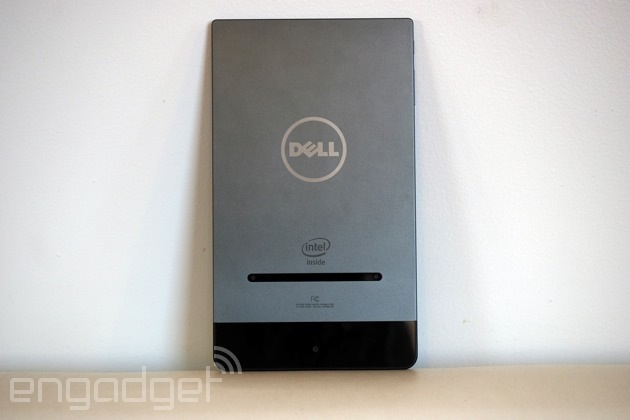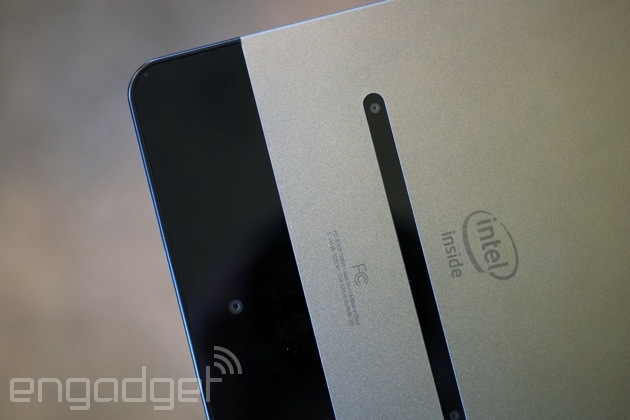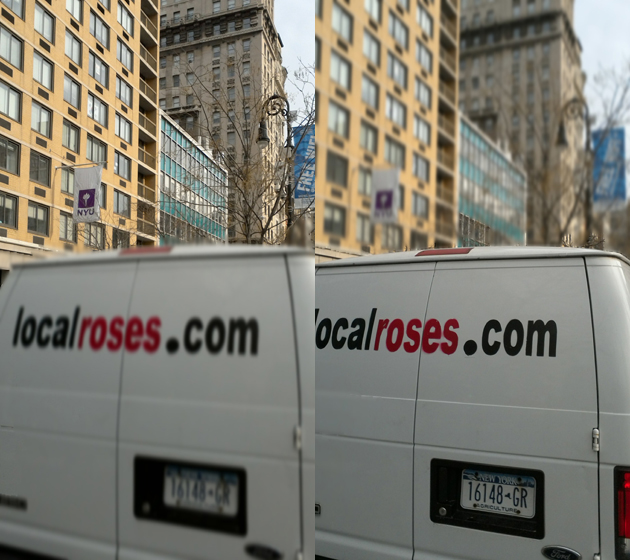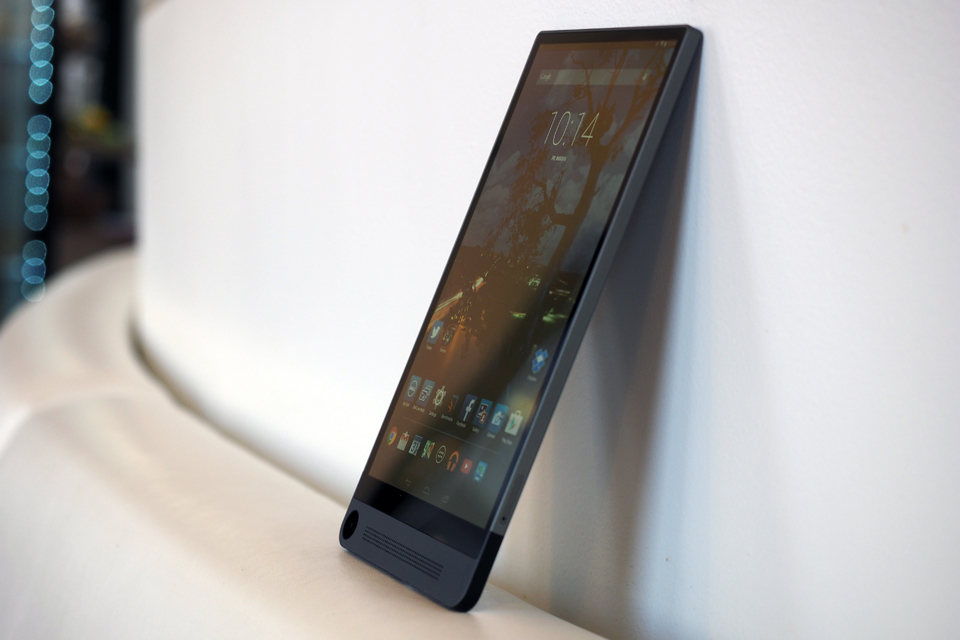Engadget doesn't review many tablets anymore. When it comes to
Android devices, we're far more likely to write about phablets, those
supersized smartphones that for many people have eliminated the need for
a dedicated slate. Meanwhile, iPad sales have slowed, and Apple has made so few changes to its products that in some cases we actually recommend you buy the previous-gen
model to save money. Still, there are some companies that continue to
not just build tablets, but also produce interesting designs. One of
them is none other than Dell, a company whose track record includes some
sensible Windows slates, a series of forgettable Android tablets and a phablet that was ahead of its time.
Lately, though, the company has been undergoing a reawakening, with a series of striking products that includes the XPS 13 and the Venue 8 7000,
a $399 Android tablet. The Venue 8, as I'll call it from here on out,
is notable mostly for its design, marked by a stunning OLED display and a
skinny 6mm-thick frame. It also happens to be the first tablet with
Intel's RealSense 3D camera setup. All told, that combination of specs
was impressive enough to win it a Best of CES Award. But does that mean you should go out and buy one?
 "That's a Dell?"
"That's a Dell?"
I can't tell you how many times I've heard that since I started using
the Venue 8 in public, and showing it off to colleagues. If you're
reading this, Dell, that's actually a compliment. A backhanded
compliment, to be sure, but high praise nonetheless. With its machined
aluminum surfaces, blunt edges and front-facing speaker setup, the Venue
8 looks like something HTC would have made back in its original HTC One phase.
It does not look like the brainchild of a company that went private so
that it could focus on making more corporate-friendly PCs.
It's actually difficult for me to say what I like best about the
design. Under duress, though, I think I'd pick the screen. What we have
here is an incredibly crisp 8.4-inch, 2,560 x 1,600 panel, slightly
larger than the iPad mini's, with a slightly higher pixel density to
match (361 pixels per inch versus 326 on the mini 3).
But the sharpness is only part of the story. The OLED display also
brings deep blacks, white whites, bright colors and strong viewing
angles. Every time I pick up an OLED tablet, whether it be the Samsung Galaxy Tab S or the older Galaxy Tab 7.7,
I find myself floored by the beauty. As a bonus, the battery life on
those devices also tends to be pretty epic. What can I say, then? It
hasn't gotten old for me -- especially since relatively few tablets even
have screens like this. I'm not sure why they're still so rare -- it's
clearly possible to build a reasonably priced OLED tablet -- but in any
case, I'm glad Dell went with the best possible option. It makes a
difference.
Last thing about the display before I move on: It's nearly
bezel-less. Other than a thin metal band about as thick as a fingernail,
it's all screen, from edge to edge. Even the black space surrounding
the screen is minimal. It's a gorgeous sight, all those lit-up pixels,
but it does at times feel a little impractical. If I'm holding the
display in portrait mode, as it was primarily meant to be used, my
thumbs cover both the metal bezel and even the black buffer space,
leaving me no choice but to block the picture with my fingers. I could
hold on at the bottom too, but that makes for some uncomfortable weight
distribution and besides, my fingers will end up covering the
front-facing speaker located below the display.
 So long as I'm talking about what it feels like to hold the device,
So long as I'm talking about what it feels like to hold the device,
this might be a good time to mention the Venue 8's aluminum shell. At
6mm thick, this is the world's thinnest tablet, or so Dell says, and
it's also lighter than you'd expect an all-metal device to be, at 0.67
pound. (For comparison's sake, the iPad mini 3 weighs 0.73 pound.) The
Venue 8 feels well-crafted, like someone spent a lot of time thinking
about how durable the tablet should be, or how nice it is to press your
fingers against cold, hard metal. In a word, it feels expensive.
Unfortunately, it doesn't seem someone spent as much time thinking about
the camera placement. The three cameras in Intel's RealSense setup are
housed on the rear of the tablet toward the bottom, with two of them
inside a thin strip, and one inside a wider panel along the lower edge.
If you're holding the tablet in portrait, your fingers will almost
certainly be blocking one of the lenses, which means you'll almost
certainly need to flip the tablet upside-down to take a shot.
Fortunately, all of the other ports are exactly where you'd expect
them to be. Along the left-hand side are your usual power button and
volume rocker. The good news is that because they're up toward the top,
you're unlikely to press them accidentally. The bad news: They won't be
in thumb's reach if you're using the thing in portrait mode. Ah well.
Moving on, there's a pin-locked microSD slot on the lower-right edge,
which accepts cards as large as 512GB, and which also has room for a SIM
card on the forthcoming LTE model. (My review unit was WiFi-only.) Up
front is a 2-megapixel webcam for video chats and the occasional selfie.
Last but not least, there's a standard micro-USB socket on the bottom
edge for charging and data transfer. Pretty standard stuff.
 So far, I've referred to RealSense as a "3D" camera setup. The better
So far, I've referred to RealSense as a "3D" camera setup. The better
term might actually be "depth-sensing." In addition to an 8-megapixel
rear camera -- clearly, the main shooter -- you get two stereoscopic
720p cameras on either side, which allow the device to collect multiple
layers of depth information. So, when you take a shot in the camera's
special depth-sensing mode (this part is important), what you're
actually getting is an amalgam of several shots: one with the foreground
in focus, one with the background, et cetera. This allows you to do
some interesting things. Using Dell's included "Gallery" app, you can
adjust the focus of the shot, blurring out the background to focus on
the foreground, or vice versa. And, because the shot is broken down into
several pieces, you can apply effects selectively, too (think: sepia in
the foreground only). Think of it as owning a Lytro, except instead of a single-purpose, one-trick camera, you also get a full-featured Android tablet.
Android devices, we're far more likely to write about phablets, those
supersized smartphones that for many people have eliminated the need for
a dedicated slate. Meanwhile, iPad sales have slowed, and Apple has made so few changes to its products that in some cases we actually recommend you buy the previous-gen
model to save money. Still, there are some companies that continue to
not just build tablets, but also produce interesting designs. One of
them is none other than Dell, a company whose track record includes some
sensible Windows slates, a series of forgettable Android tablets and a phablet that was ahead of its time.
Lately, though, the company has been undergoing a reawakening, with a series of striking products that includes the XPS 13 and the Venue 8 7000,
a $399 Android tablet. The Venue 8, as I'll call it from here on out,
is notable mostly for its design, marked by a stunning OLED display and a
skinny 6mm-thick frame. It also happens to be the first tablet with
Intel's RealSense 3D camera setup. All told, that combination of specs
was impressive enough to win it a Best of CES Award. But does that mean you should go out and buy one?
Venue 8 7000
Summary
Dell's flagship Venue 8 tablet is thin and well-made with a
stunning screen and long battery life. It's one of the best Android
slates you can buy, but we'd like it even more if the image quality from
the camera were better -- and if it weren't so easy to cover up the
speaker and rear lens with your fingers.
Dell's flagship Venue 8 tablet is thin and well-made with a
stunning screen and long battery life. It's one of the best Android
slates you can buy, but we'd like it even more if the image quality from
the camera were better -- and if it weren't so easy to cover up the
speaker and rear lens with your fingers.
Hardware

I can't tell you how many times I've heard that since I started using
the Venue 8 in public, and showing it off to colleagues. If you're
reading this, Dell, that's actually a compliment. A backhanded
compliment, to be sure, but high praise nonetheless. With its machined
aluminum surfaces, blunt edges and front-facing speaker setup, the Venue
8 looks like something HTC would have made back in its original HTC One phase.
It does not look like the brainchild of a company that went private so
that it could focus on making more corporate-friendly PCs.
It's actually difficult for me to say what I like best about the
design. Under duress, though, I think I'd pick the screen. What we have
here is an incredibly crisp 8.4-inch, 2,560 x 1,600 panel, slightly
larger than the iPad mini's, with a slightly higher pixel density to
match (361 pixels per inch versus 326 on the mini 3).
But the sharpness is only part of the story. The OLED display also
brings deep blacks, white whites, bright colors and strong viewing
angles. Every time I pick up an OLED tablet, whether it be the Samsung Galaxy Tab S or the older Galaxy Tab 7.7,
I find myself floored by the beauty. As a bonus, the battery life on
those devices also tends to be pretty epic. What can I say, then? It
hasn't gotten old for me -- especially since relatively few tablets even
have screens like this. I'm not sure why they're still so rare -- it's
clearly possible to build a reasonably priced OLED tablet -- but in any
case, I'm glad Dell went with the best possible option. It makes a
difference.
Last thing about the display before I move on: It's nearly
bezel-less. Other than a thin metal band about as thick as a fingernail,
it's all screen, from edge to edge. Even the black space surrounding
the screen is minimal. It's a gorgeous sight, all those lit-up pixels,
but it does at times feel a little impractical. If I'm holding the
display in portrait mode, as it was primarily meant to be used, my
thumbs cover both the metal bezel and even the black buffer space,
leaving me no choice but to block the picture with my fingers. I could
hold on at the bottom too, but that makes for some uncomfortable weight
distribution and besides, my fingers will end up covering the
front-facing speaker located below the display.

this might be a good time to mention the Venue 8's aluminum shell. At
6mm thick, this is the world's thinnest tablet, or so Dell says, and
it's also lighter than you'd expect an all-metal device to be, at 0.67
pound. (For comparison's sake, the iPad mini 3 weighs 0.73 pound.) The
Venue 8 feels well-crafted, like someone spent a lot of time thinking
about how durable the tablet should be, or how nice it is to press your
fingers against cold, hard metal. In a word, it feels expensive.
Unfortunately, it doesn't seem someone spent as much time thinking about
the camera placement. The three cameras in Intel's RealSense setup are
housed on the rear of the tablet toward the bottom, with two of them
inside a thin strip, and one inside a wider panel along the lower edge.
If you're holding the tablet in portrait, your fingers will almost
certainly be blocking one of the lenses, which means you'll almost
certainly need to flip the tablet upside-down to take a shot.
Fortunately, all of the other ports are exactly where you'd expect
them to be. Along the left-hand side are your usual power button and
volume rocker. The good news is that because they're up toward the top,
you're unlikely to press them accidentally. The bad news: They won't be
in thumb's reach if you're using the thing in portrait mode. Ah well.
Moving on, there's a pin-locked microSD slot on the lower-right edge,
which accepts cards as large as 512GB, and which also has room for a SIM
card on the forthcoming LTE model. (My review unit was WiFi-only.) Up
front is a 2-megapixel webcam for video chats and the occasional selfie.
Last but not least, there's a standard micro-USB socket on the bottom
edge for charging and data transfer. Pretty standard stuff.
Camera

term might actually be "depth-sensing." In addition to an 8-megapixel
rear camera -- clearly, the main shooter -- you get two stereoscopic
720p cameras on either side, which allow the device to collect multiple
layers of depth information. So, when you take a shot in the camera's
special depth-sensing mode (this part is important), what you're
actually getting is an amalgam of several shots: one with the foreground
in focus, one with the background, et cetera. This allows you to do
some interesting things. Using Dell's included "Gallery" app, you can
adjust the focus of the shot, blurring out the background to focus on
the foreground, or vice versa. And, because the shot is broken down into
several pieces, you can apply effects selectively, too (think: sepia in
the foreground only). Think of it as owning a Lytro, except instead of a single-purpose, one-trick camera, you also get a full-featured Android tablet.

Try This Amazing app DRAGON BALL Z DOKKAN BATTLE Mod Apk
ReplyDelete